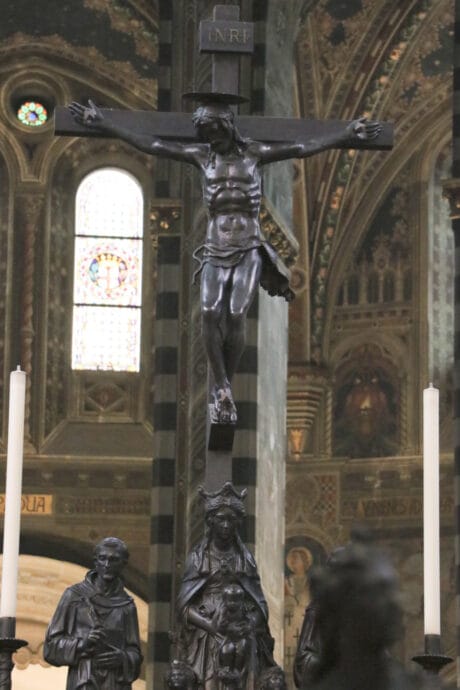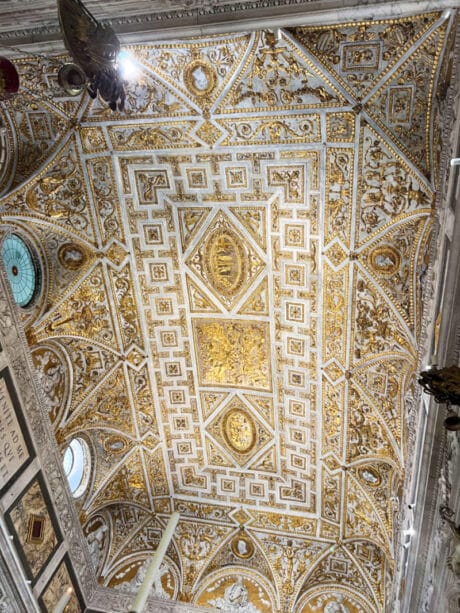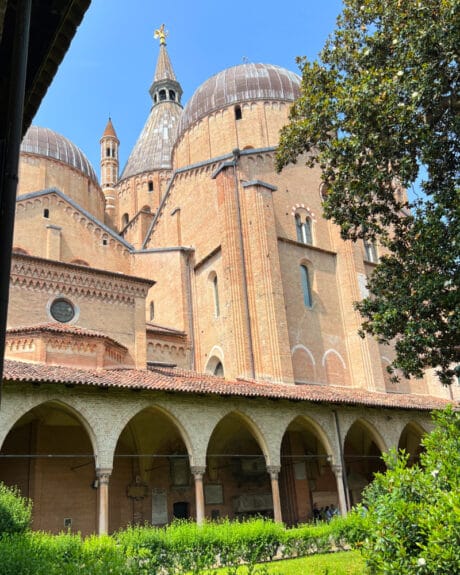The Basilica of St. Anthony (Basilica di Sant’Antonio in Padova), Italy, is one of the two top sights to visit in Padua and a must-see even on the shortest stopover or day-trip excursion.
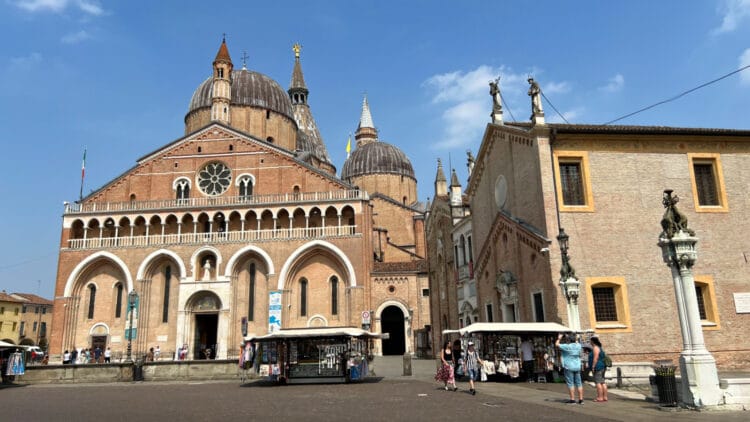
The monumental Basilica of St. Anthony in Padua is a monumental tribute to one of Christianity’s most beloved saints. The stunning blend of Romanesque, Gothic, and Byzantine elements, as well as impressive artworks, makes this historic church worth exploring by all travelers and pilgrims. Opening hours are long and admission is free. Scan QR codes inside the basilica for a free audio guide or book a guided day-trip tour of Padua.
Historical Origins of the Basilica of St. Anthony in Padua
Construction of the Basilica of Saint Anthony commenced in 1232, just a year after his death in Padua. The initially modest church soon expanded to a large and extensive basilica complex with numerous attached structures, chapels, and Franciscan monasteries, including several fine cloisters.
While the main structure of the nave dates from the 13th century, the choir and apse were added in the mid-15th century. The last chapel (off the apse) was completed in the late 17th century. The most impressive decorations and art in the church are from the Gothic or Renaissance periods.
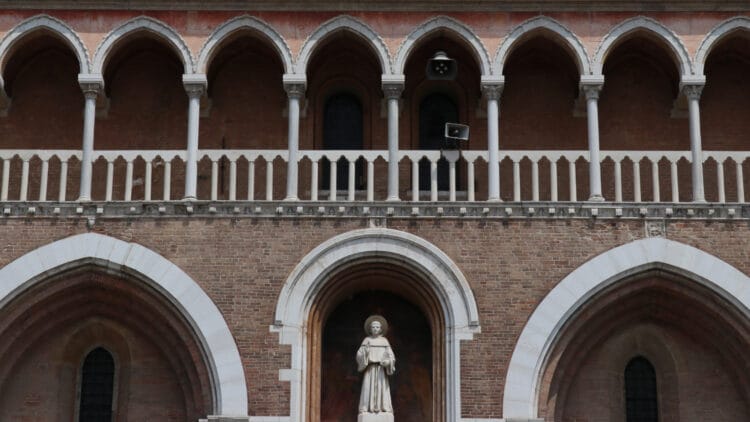
Who Was Saint Anthony of Padua?
Saint Anthony (c. 1195-1231), a Portuguese Franciscan friar, became renowned for his preaching, theological insights, and reputed miracles. His death in Padua led to an overwhelming surge of devotion, prompting the immediate construction of a church to house his remains. His canonization came just a year after his death.
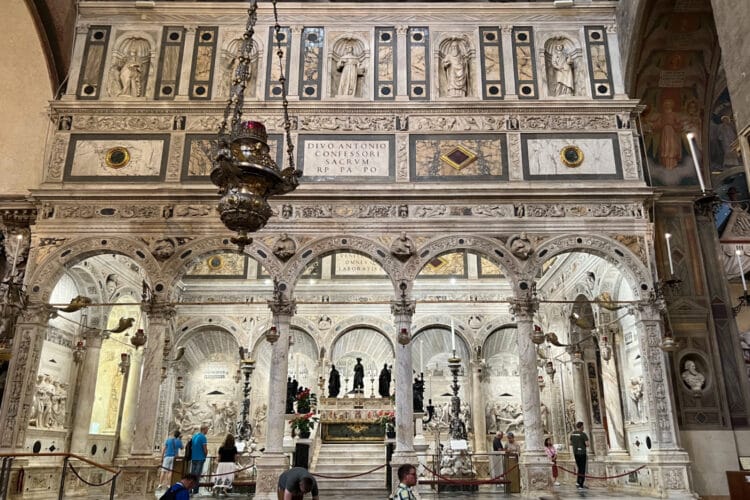
St Anthony is the Patron Saint of:
- Lost and stolen items
- The poor
- Travelers
- Sailors
- Pregnant women
Some of the miracles attributed to St Anthony include:
- Preaching to fish when people ignored him
- Reattaching a severed foot
- Finding lost objects
His feast day is June 13, celebrated worldwide, but especially in Portugal, Italy, Brazil, and among the Franciscan communities. Avoid traveling to Padua in mid-June if visiting to appreciate the art rather than as a pilgrimage.
Architectural Styles
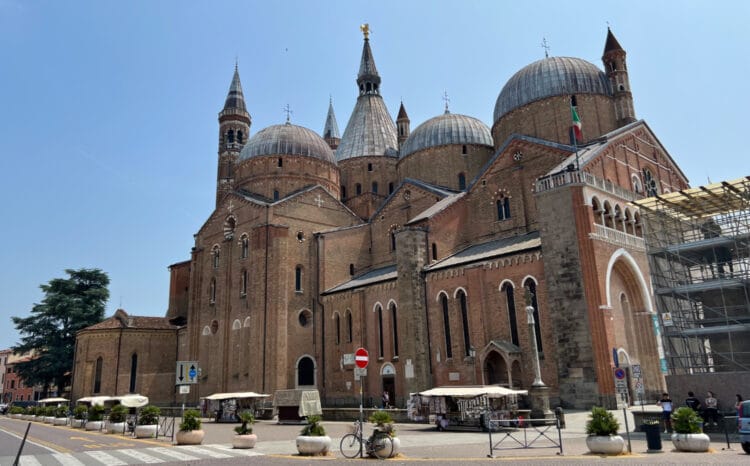
The Basilica of St. Anthony in Padua is a unique synthesis of architectural styles blending Romanesque, Gothic, and Byzantine elements to give this church a one-of-a-kind appearance that reflects the diversity of medieval Europe.
The base has the solid, rounded arches of Romanesque architecture. However, the basilica’s overall silhouette is unmistakably Gothic, with pointed arches, ribbed vaults, and soaring spires.
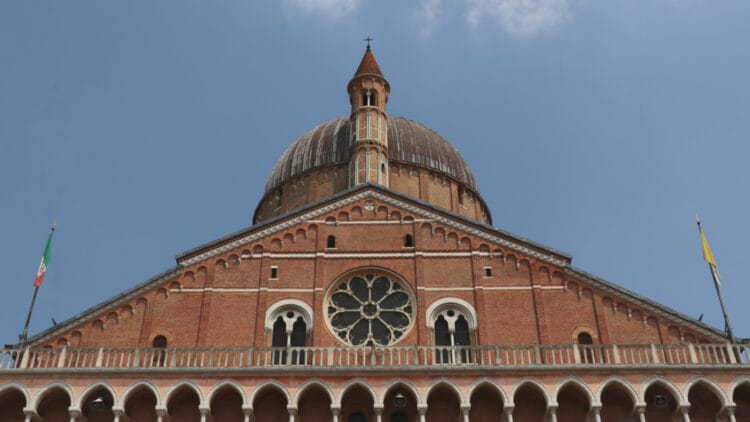
Adding to its distinctiveness is a striking Byzantine influence, most notably in the domes that crown the structure and small belfries recalling Turkish minarets. These domes, reminiscent of Eastern Orthodox churches, give the basilica a Middle Eastern flair, reflecting the cross-cultural influences that permeated medieval Venice. This is particularly noticeable when viewing the church in profile rather than directly from the front.
The exterior is adorned with statues, carvings, and intricate brickwork, each narrating a facet of the basilica’s layered history.
Basilica or Cathedral of Padua?
Don’t confuse the Basilica of St Anthony (Basilica di Sant’Antonio di Padova), also known as il Santo, with the cathedral (Duomo) of Padua. The large Renaissance cathedral in the city center is surprisingly bland and hardly worth seeing, despite the architect claiming inspiration from Michelangelo. Padua’s top art highlight, the Giotto frescoes in the Scrovegni Chapel, is also at a completely different location.
Donatello’s Gattamelata Equestrian Statue in Padua
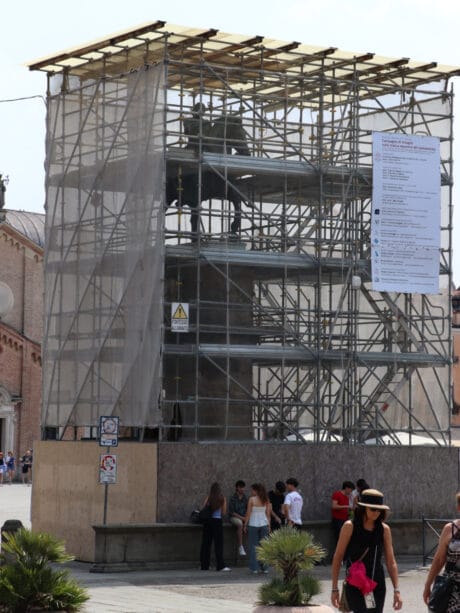
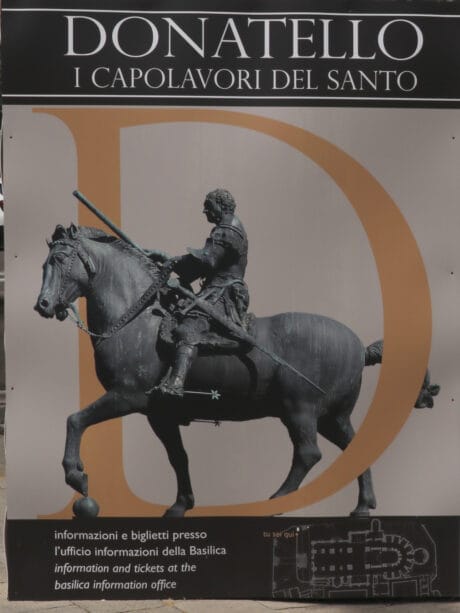
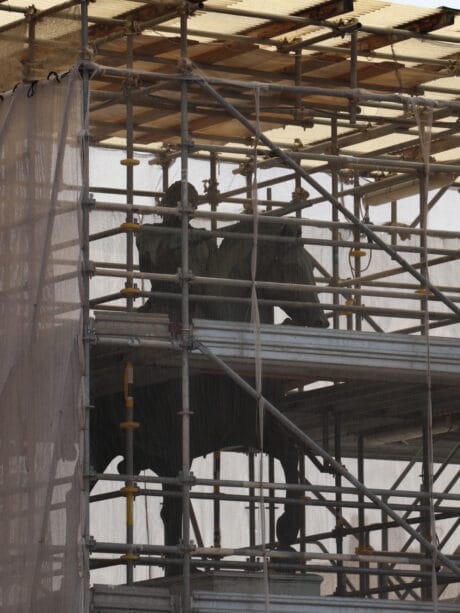
Outside the basilica, Donatello’s equestrian statue of the condottiero Erasmo da Narni, known as Gattamelata, was groundbreaking. (Erasmo, who died in Padua in 1446, was a General Captain of the Venetian army.)
This sculpture is not just another now forgotten man on a horse. It was the first full-size bronze equestrian statue since antiquity, symbolizing both artistic revival and civic pride.
Donatello was inspired by the statue of Marcus Aurelius in Rome (now in the Capitoline Museum in Rome), which is the finest surviving equestrian bronze sculpture from antiquity. Around 1450, Donatello assembled around 36 bronze elements to present Gattamelata not as a divine ruler but as a composed, human commander — serious, dignified, and grounded in reality. The horse, carefully proportioned, stands in a calm but powerful pose, while the rider exudes silent authority.
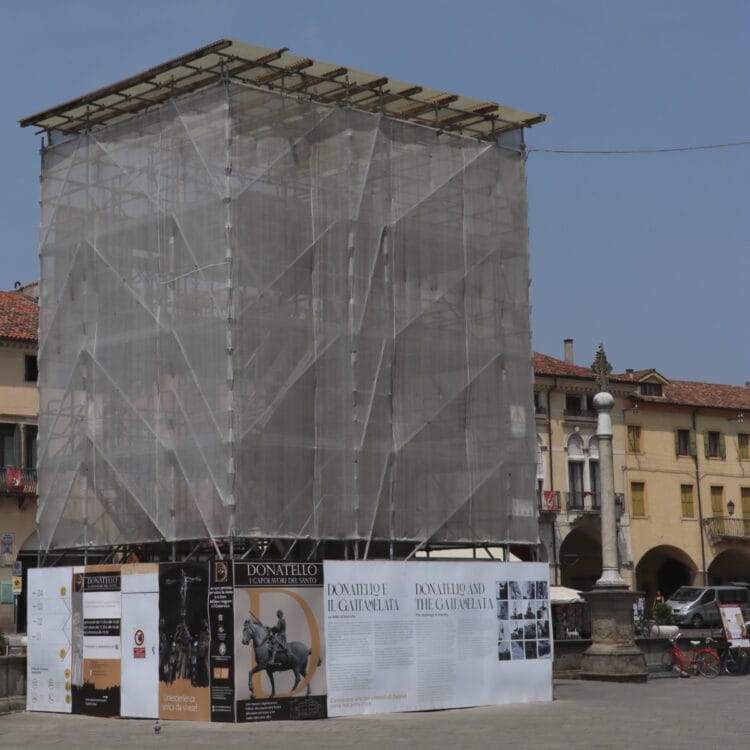
Its classical form, realistic detail, and humanistic tone influenced generations of Renaissance sculptors and redefined public monuments. A wooden copy of the horse is in the Palazzo della Ragione in Padua, while copies of Donatello’s horse heads are in various museums around the world.
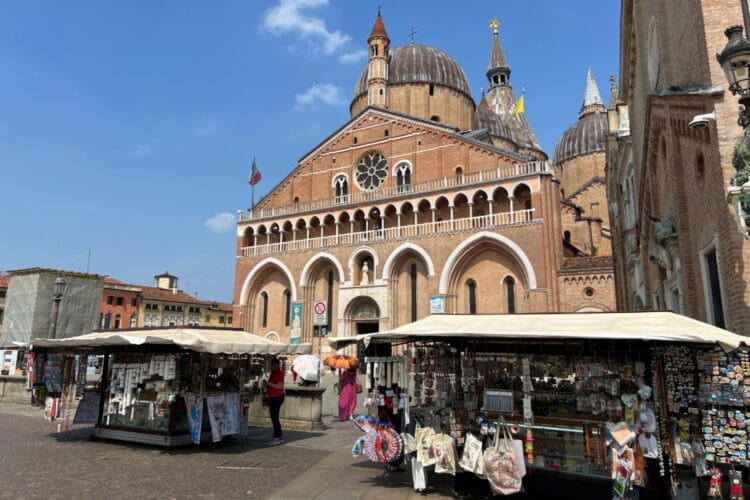
The sculpture was disassembled and removed for safekeeping during both world wars but is currently being restored in situ.
(Donatello’s bronze David, now in the Bargello in Florence, was similarly the first full-round bronze male nude since antiquity. It inspired Michelangelo to carve his even more famous marble David also as a nude.)
Visit the Interior of the Basilica of St Anthony in Padua
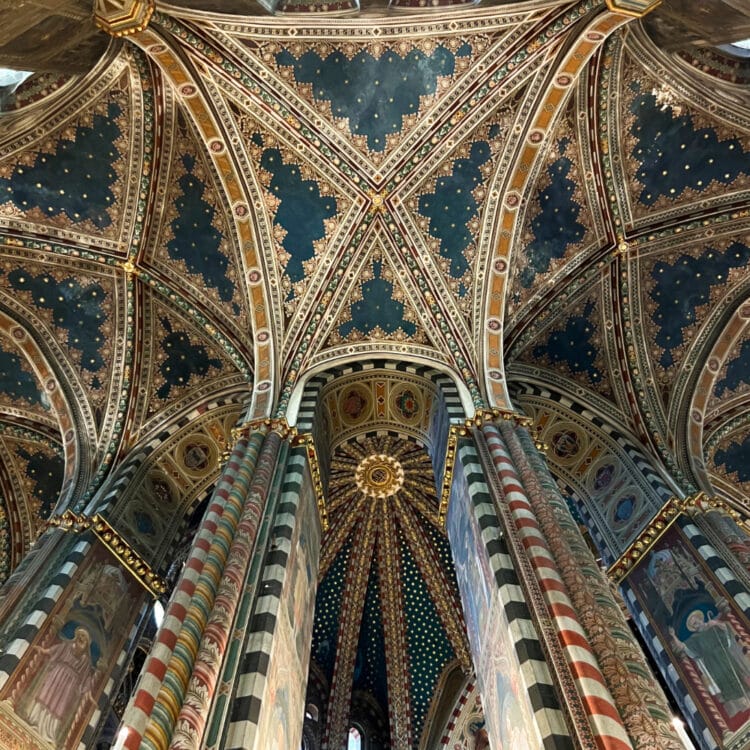
Inside, the church follows a typical basilica layout with three naves but no protruding transept. The nave is expansive, lined with massive columns that draw the eyes upward to vaulted ceilings, which are particularly beautifully decorated towards the front, choir, and apse of the church.
High Altar with Donatello Sculptures
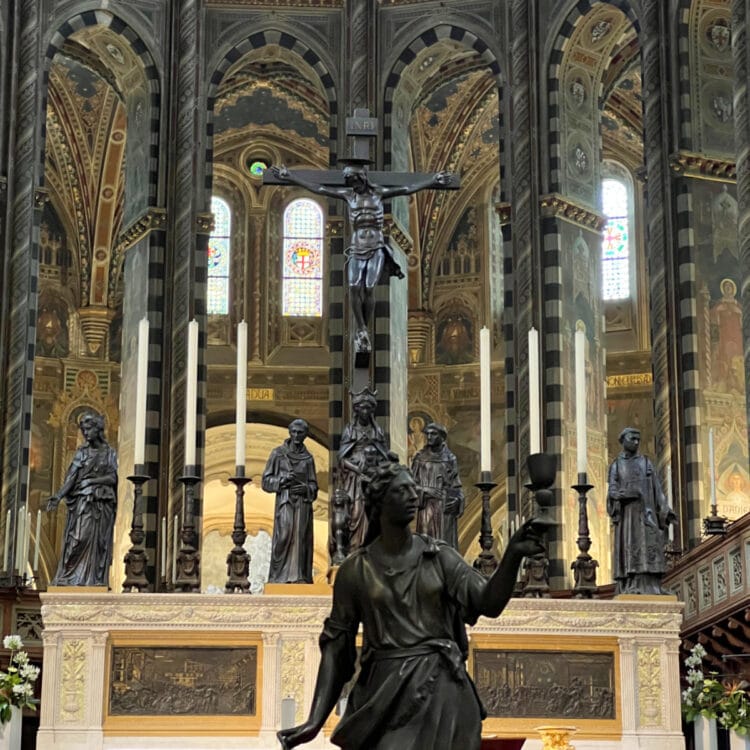
The High Altar, designed by Renaissance master Tullio Lombardo and later enhanced by Donatello, is a focal point of liturgical and artistic importance. It received its current form in 1895 when Camillo Boito moved all 30 bronzes by Donatello to the altar.
In the mid-15th century, the Florentine artist Donatello (c. 1386 – 1466) created works for the High Altar (and for other chapels). These included the life-size bronze sculptures of the Virgin Mary and six saints. His large Crucifix, which emphasized the humanity of Christ, was not originally intended for the altar but rather the middle of the church.
The four reliefs at the base illustrating the miracles of St Anthony are particularly impressive. Donatello managed to present six levels of perspective in a depth of less than an inch (2 cm).
Lorenzo and Cristoforo Canozi da Lendinara completed the wooden choir stalls by 1462.
Pilgrimage and Devotion
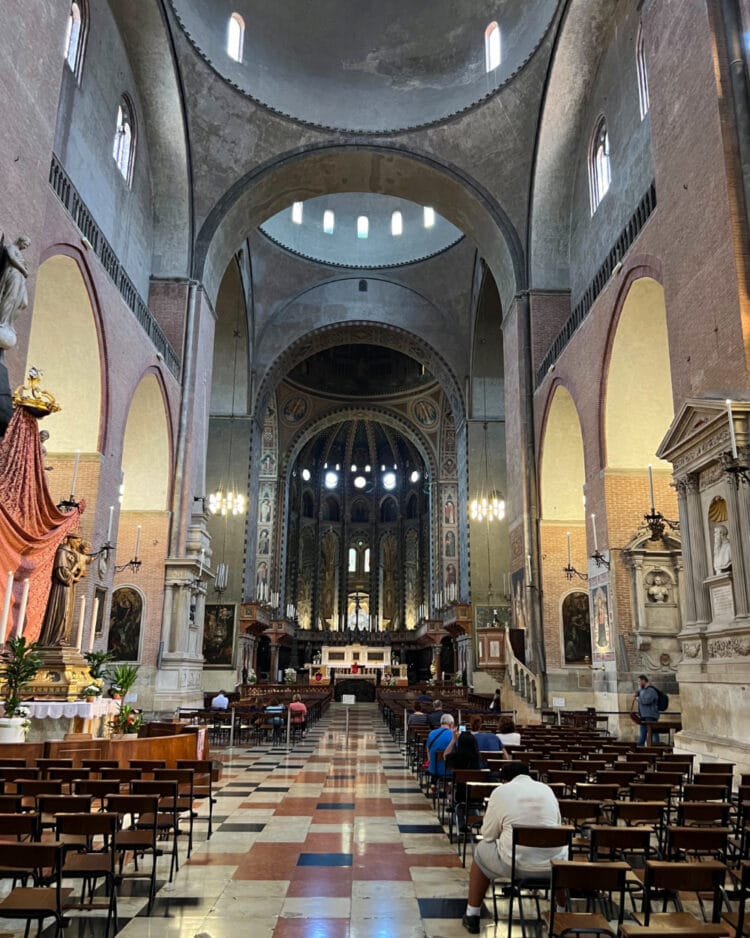
The Basilica of St. Anthony is not merely an architectural and artistic treasure; it is also a living center of faith. Pilgrims from around the world come to pay homage to the saint, seek spiritual solace, and pray for intercession. (Mid-afternoon is probably the best time to visit as a tourist to avoid areas of the church being closed for services or ceremonies.)
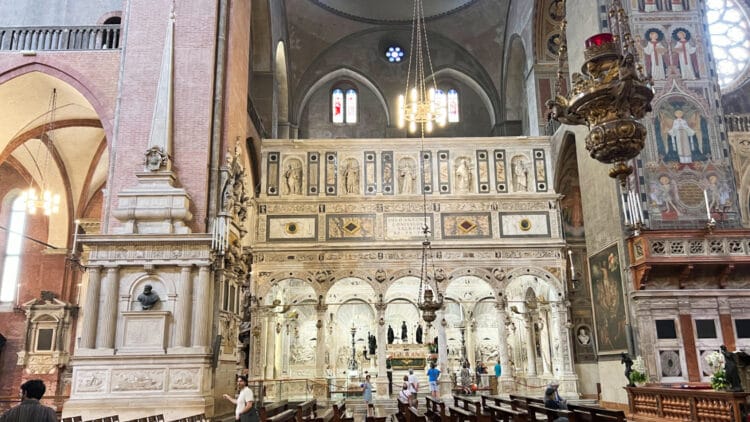
The Tomb of Saint Anthony
The Tomb of Saint Anthony (Arco / Tomba del Santo), located in the left transept, is a constant focal point for pilgrims. It is very easy to recognize.
In addition to large signs, it is impossible to miss the bright, mostly white marble decorations of this Renaissance chapel. It has a splendid gold and white ceiling.
Known as the “Ark of Saint Anthony”, the tomb is a richly decorated marble structure that houses the saint’s remains. (Some “parts” are displayed as relics in the treasury.) The tomb was designed in the 16th century and features reliefs by renowned sculptors, including Tullio Lombardo and Sansovino, depicting scenes from the life and miracles of the saint.
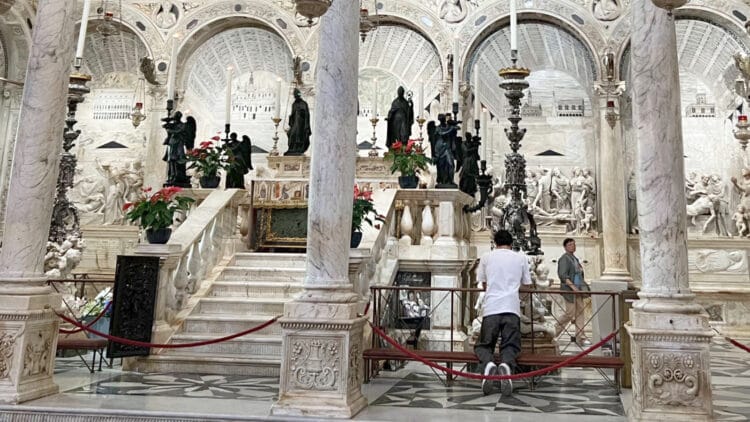
Visitors often leave written prayers and touch the tomb in a gesture of devotion. The atmosphere is one of reverence and hope, testifying to the saint’s enduring spiritual presence.
On June 13th, the Feast of Saint Anthony, the basilica becomes the center of massive religious celebrations. Thousands gather for processions, Masses, and special ceremonies honoring the saint’s life and miracles.
Chapel of St James
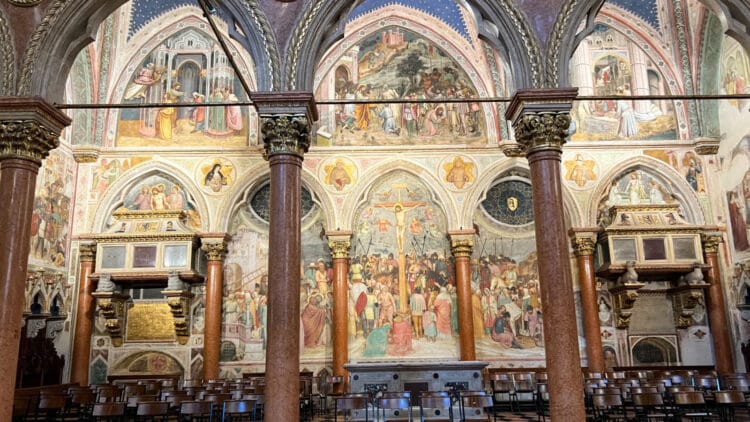
The Chapel of St. James (Cappella di San Giacomo) is on the right aisle opposite the chapel of St Anthony. Most of the late-14th-century paintwork is by the Veronese artist Altichiero da Zevio and the Bolognese painter Jacopo Avanzo. The lavish frescoes depict events from the life of St James the Greater.
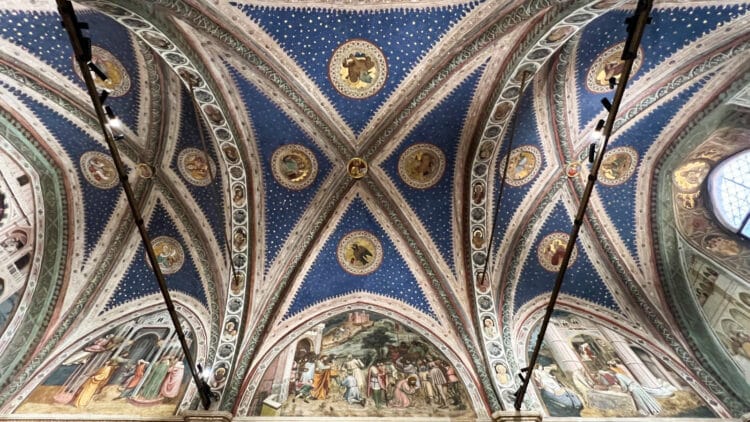
The frescoes are of exceptional quality, as are the ceiling decorations. Although painted decades after Giotto’s proto-renaissance frescoes in the Scrovegni Chapel, these are among the finest examples of Gothic painting in Northern Italy.
St Anthony’s chapel must have been very similar before it received its Renaissance marble makeover in the 16th century.
Chapel of the Relics
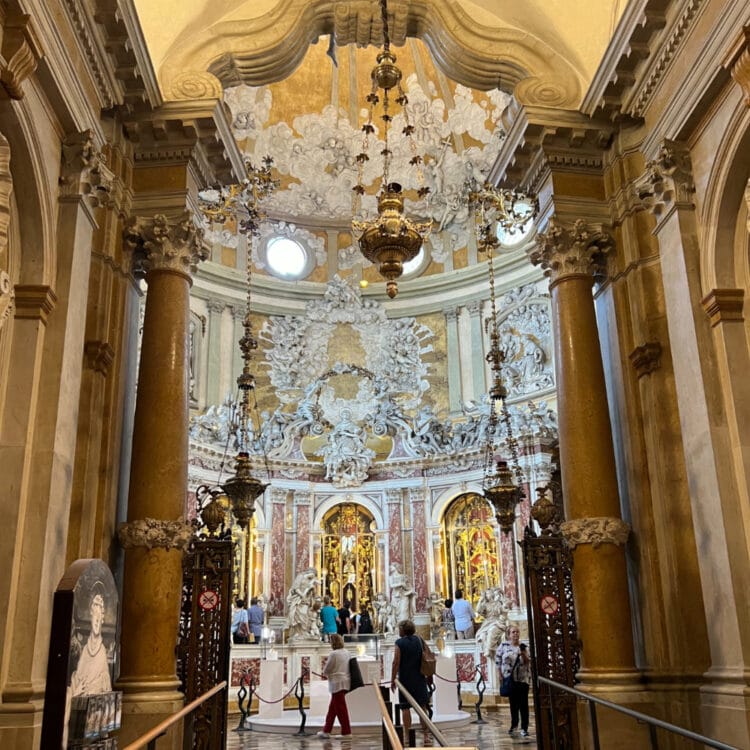
Among the many chapels within the basilica, the Chapel of the Relics (Treasury Chapel) in the apse behind the choir holds particular significance. This Roman Baroque style chapel, completed at the end of the 17th century, is the newest in the church.
The three relics of St Anthony are by far the most famous of all the reliquaries and relics displayed here. His chin (or jawbone) was removed in a special operation in 1350 — a fresco in the Little School (see below) recalls the event. Around 1434, when his body was moved into a new tomb, it was discovered that his tongue was perfectly preserved, so it was placed in a reliquary too. As late as 1982, St Anthony’s vocal cords were found in good condition, and it is now also on display. The latter two relics are particularly apt as St Anthony was famous for his oratory powers.
These relics are displayed in ornate reliquaries, objects of both religious veneration and artistic craftsmanship. (A bit bizarre for the non-devoit but less grim than you might have thought.)
The Chapel of the Relics closes from noon to 14:30 on weekdays. Admission free.
Directly next to the Chapel of the Relics is the Chapel of Blessings. Anyone may receive a blessing here from the priest — no set fee. (Usually possible from 9:00 to 17:00, Sundays afternoons only.)
Cloisters
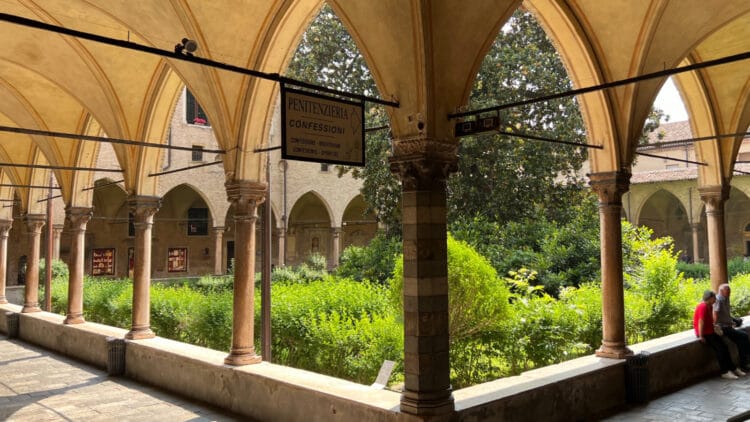
The large cloisters of the basilica also offer serene beauty. They reflect the Franciscan emphasis on simplicity, nature, and spiritual introspection.
Three of the four large cloisters in the basilica complex are open to visitors. Architecturally, the cloisters reflect a blend of Romanesque, Gothic, and early Renaissance styles, with carved capitals, frescoed walls, and a decorative wellhead.
Don’t miss these cloisters. Access is from inside the church to the left of the Chapel of St James, or through a door to the right of the main facade off the main square.
Museums and Exhibitions
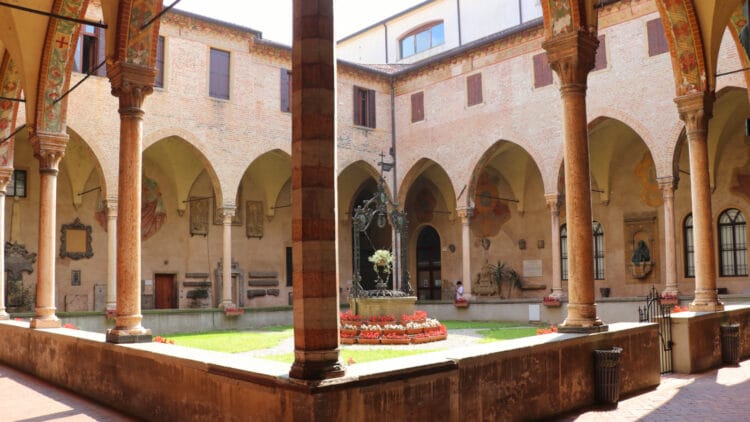
Admission to the basilica and cloisters is free, but not to the museums (access via the cloisters) and the two art-filled chapels off the main plaza. These sights have the same combination ticket and opening hours (closed on Monday and for lunch).
Museums
The museums may be of lesser interest to most visitors, but include:
- The Antonian Museum showcases a collection of paintings, sculptures, liturgical objects, textiles, and silverwork. A highlight is the “Donatello al Santo” exhibit, featuring plaster casts and displays on Donatello’s work for the basilica.
- The Museum of Popular Devotion displays hundreds of ex-voto offerings left in thanks for miracles.
- A free multimedia exhibition provides a 25-minute film on Saint Anthony’s life and legacy.
Oratoria di S. Giorgio / Oratory of St George
The Oratoria di S. Giorgio / Oratory of St George dates from 1377 and was originally an aristocratic funerary chapel. The interior was painted by Altichiero da Zevio, who also did the chapel of St James inside the basilica. The decorations include scenes from the life of Christ, several saints, and especially St George, who was the patron saint of the Marquis Lupi di Soragna.
Admission charged — either a combination ticket with the other basilica sights or the Urbs Picta Card.
Scoletta / Little School
The Scoletta, or Little School, was the seat of the 15th-century Confraternity of St Anthony. The main attraction is the Priory Hall on the second floor.
This room is decorated with 18 frescoes on the life of St Anthony, including three by a young Titian Vecellio.
Museums Opening Hours and Tickets
Admission to the basilica and most of the complex is free and without tickets or time-slot reservations.
Admission is only charged for the Oratory of St George, the Little School, the Antonian Museum and the Museum of Popular Devotion. These sites are seen on a combination ticket for €10 (€20 for a family). (The Oratory of St George is also included in the Urbs Picta Card.)
These museums are open Tuesday to Sunday from 9:00 to 13:00 and 14:00 to 18:00. Closed on Mondays and many holidays.
Visitor Information: Basilica of St Anthony in Padua
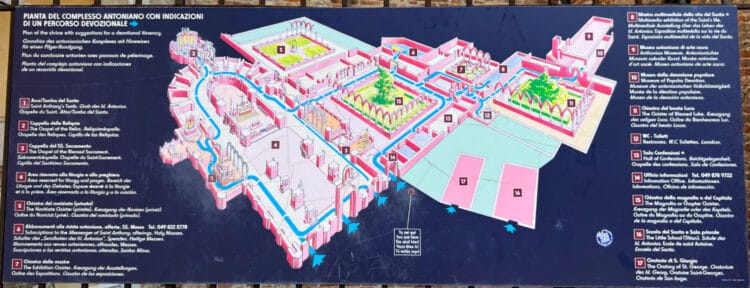
Opening Hours
The Basilica of St Anthony in Padua is open daily from 6:15 to 19:00, last entry around 18:30. However, as it’s a working church with seven to nine masses per day, tourist visiting hours are more limited. Depending on the service, various sections of the church may be closed.
The Chapel of the Relics is open from around 9:00 to 19:00 but is closed on weekdays between noon and 14:30. The museums are closed on Mondays and daily between 13:00 and 14:00.
For tourist visits, the best times to avoid possible part closures are early to mid-afternoon (14:00 to 16:00). Except for high holidays, most of the basilica remains open for tourist visits even during mass.
Transportation to the Basilica of St Anthony in Padua
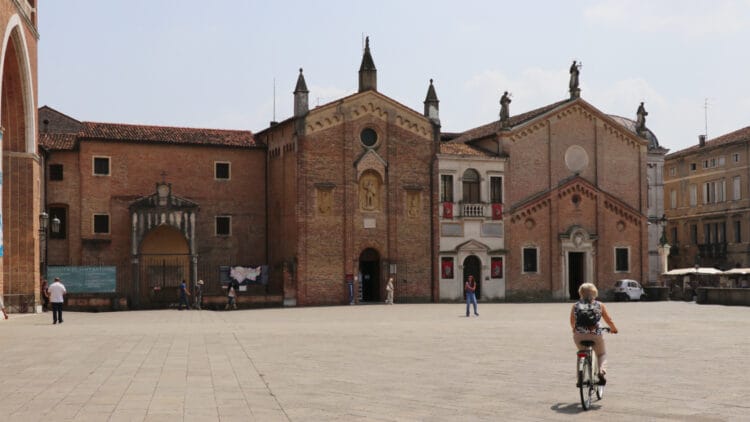
The Basilica of St. Anthony in Padua (Basilica di Sant’Antonio), Piazza del Santo, 11, 35123 Padova PD, Italy, is to the south of the center of Padua. Do not confuse the basilica with the cathedral in the center or the famous Scrovegni Chapel to the north of the center near the station.
To get to the basilica from the train station is an easy 30-minute walk, or simply take the tram to the Basilica stop. Scan a bank card when entering the tram (no need to scan out or buy paper tickets). Also consider taking the tram one stop further to have a look at the Prato della Valle square and then walk two blocks back to the basilica.
More on Padua near Venice in Italy
Padua (Padova) is a popular day-trip excursion destination from Venice, but the art and architecture here are worth a journey:
- → Top Sights to See in Padua (Padova)
- → Visit the Basilica of St Anthony — free, long opening hours.
- → How to Buy Tickets for the Scrovegni Chapel in Padua — although not very difficult to secure compulsory time-slot reservations, tickets must be bought a day in advance!
- → Giotto’s frescoes in the Scrovegni Chapel, which include the Life of Joachim and Anne: Parents of the Virgin Mary
- → By Train to Padova (for an easy day-trip or stopover from Venice)
- → Book Hotels in Padua
- → Book Luggage Storage near Padova Station

